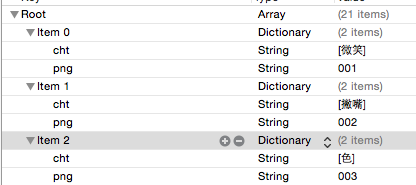弃坑简书,从简书搬家到掘金,正好把之前这篇文章改为Markdown模式。
开头
本文是技术集中的第一篇技术性文章,所以就记录一点简单且浅显易懂的东西。
现在即时通讯和朋友圈这两块功能基本上属于app的标配功能了吧。图文混排在这两块中使用最为常见,我已经做好了demo:图文混排Demo。
文中会讲述几点小技巧:图文混排、动态计算文字长度、图片拉伸方法。
以前的做法
在以前做图文混排的时候,经常使用OHAttributedLabel,后来苹果吸取了一些第三方的优点,对NSString做了扩展,作者也不再更新,推荐用系统的方法来实现图文混排。具体请自行百度或者google关键字OHAttributedLabel。
现在的做法
苹果在iOS7中推出了一个新的类NSTextAttachment,它是做图文混排的利器,本文就是用这个类,只用50行代码实现文字与表情混排,当然也可以实现段落中的图文混排,与CoreText比起来实在是简单了太多,下面讲述两个案例。(更新:YYKit中的YYTextAttachment,应该就是从NSTextAttachment上找的灵感吧)
案例一
先上效果图,聊天界面中的图文混排

要实现这样的效果,code4app上似乎有很多种做法,还有一些奇葩的一个字符一个label,但是今天要讲述的做法,是目前为止我看到的最简单的做法了,只用一个UILabel,需要用到UILabel的attributedText属性。
首先,需要组装一个表情和文字对应的plist文件,plist中的键值对如下:

本文用一个工具类来实现一个转换的方法,你也可以给NSString添加一个类别来实现。
第一步,解析plist文件,转化为数组。
NSString *filePath = [[NSBundle mainBundle] pathForResource:@"emoticons" ofType:@"plist"];
NSArray *face = [NSArray arrayWithContentsOfFile:filePath];
第二步,将字符串转换为可变属性字符串,并通过正则表达式匹配出所有的要替换的字符。
//1、创建一个可变的属性字符串
NSMutableAttributedString *attributeString = [[NSMutableAttributedString alloc] initWithString:text];
//2、通过正则表达式来匹配字符串
NSString *regex_emoji = @"\\[[a-zA-Z0-9\\/\\u4e00-\\u9fa5]+\\]";//匹配表情
NSError *error =nil;
NSRegularExpression *re = [NSRegularExpression regularExpressionWithPattern:regex_emoji options:NSRegularExpressionCaseInsensitive error:&error];
if (!re) {
NSLog(@"%@", [errorlocalizedDescription]);
return attributeString;
}
NSArray *resultArray = [rematchesInString:text options:0 range:NSMakeRange(0, text.length)];
数组中都是NSTextCheckingResult对象,它包含了特殊字符在整个字符串中的位置等信息。
第三步,将特殊字符与对应表情关联
NSMutableArray *imageArray = [NSMutableArray arrayWithCapacity:resultArray.count];
//根据匹配范围来用图片进行相应的替换
for(NSTextCheckingResult *match in resultArray) {
//获取数组元素中得到range
NSRangerange = [match range];
//获取原字符串中对应的值
NSString*subStr = [text substringWithRange:range];
for(inti =0; i < face.count; i ++) {
if ([face[i][@"cht"] isEqualToString:subStr]) {
//face[i][@"png"]就是我们要加载的图片
//新建文字附件来存放我们的图片,iOS7才新加的对象
NSTextAttachment*textAttachment = [[NSTextAttachment alloc] init];
//给附件添加图片
textAttachment.image = [UIImage imageNamed:face[i][@"png"]];
//调整一下图片的位置,如果你的图片偏上或者偏下,调整一下bounds的y值即可
textAttachment.bounds = CGRectMake(0, -8, textAttachment.image.size.width, textAttachment.image.size.height);
//把附件转换成可变字符串,用于替换掉源字符串中的表情文字
NSAttributedString*imageStr = [NSAttributedString attributedStringWithAttachment:textAttachment];
//把图片和图片对应的位置存入字典中
NSMutableDictionary*imageDic = [NSMutableDictionary dictionaryWithCapacity:2];
[imageDic setObject:imageStr forKey:@"image"];
[imageDic setObject:[NSValuevalueWithRange:range] forKey:@"range"];
//把字典存入数组中
[imageArray addObject:imageDic];
}
}
}
第四步,将特殊字符替换成图片
// 4、从后往前替换,否则会引起位置问题
for (int i = (int)imageArray.count-1; i >=0; i--) {
NSRange range;
[imageArray[i][@"range"] getValue:&range];
//进行替换
[attributeString replaceCharactersInRange:range withAttributedString:imageArray[i][@"image"]];
}
用法:
NSString *content = @"文字加上表情[得意][酷][呲牙]";
NSMutableAttributedString *attrStr = [Utility emotionStrWithString:content];
_contentLabel.attributedText= attrStr;
案例二

需要实现的效果:
有了上面的方法,这个效果更容易实现,只需要将某些图片给它设置一个固定的字符对应即可。
与以上方法主要不同点在于正则表达式:
//2、匹配字符串
NSError *error = nil;
NSRegularExpression *re = [NSRegularExpression regularExpressionWithPattern:string options:NSRegularExpressionCaseInsensitive error:&error];
if (!re) {
NSLog(@"%@", [error localizedDescription]);
return attributeString;
}
用法:
NSString *praiseStr = @"路人甲、路人乙";
NSString *praiseInfo = [NSStringstringWithFormat:@"<点赞> %@",praiseStr];
NSDictionary *attributesForAll = @{NSFontAttributeName:[UIFontsystemFontOfSize:14.0],NSForegroundColorAttributeName:[UIColorgrayColor]};
NSMutableAttributedString *attrStr = [Utility exchangeString:@"<点赞>" withText:praiseInfoimageName:@"dynamic_love_blue"];
彩蛋
1、计算动态文字的长度
NSMutableAttributedString *content = [Utility emotionStrWithString:_dynamic.text];
[content addAttribute:NSFontAttributeName value:kContentFont range:NSMakeRange(0, content.length)];
CGSize maxSize = CGSizeMake(kDynamicWidth,MAXFLOAT);
CGSize attrStrSize = [content boundingRectWithSize:maxSize options:NSStringDrawingUsesLineFragmentOrigin context:nil].size;
其中NSMutableAttributedString类型的字符串可以添加多种属性,并且在计算的时候必须设置字符大小等属性。
2、图片拉伸
在iOS5之前可以用stretchableImageWithLeftCapWidth: topCapHeight:
iOS5之中用resizableImageWithCapInsets:
iOS6开始多了一个参数resizableImageWithCapInsets:resizingMode: